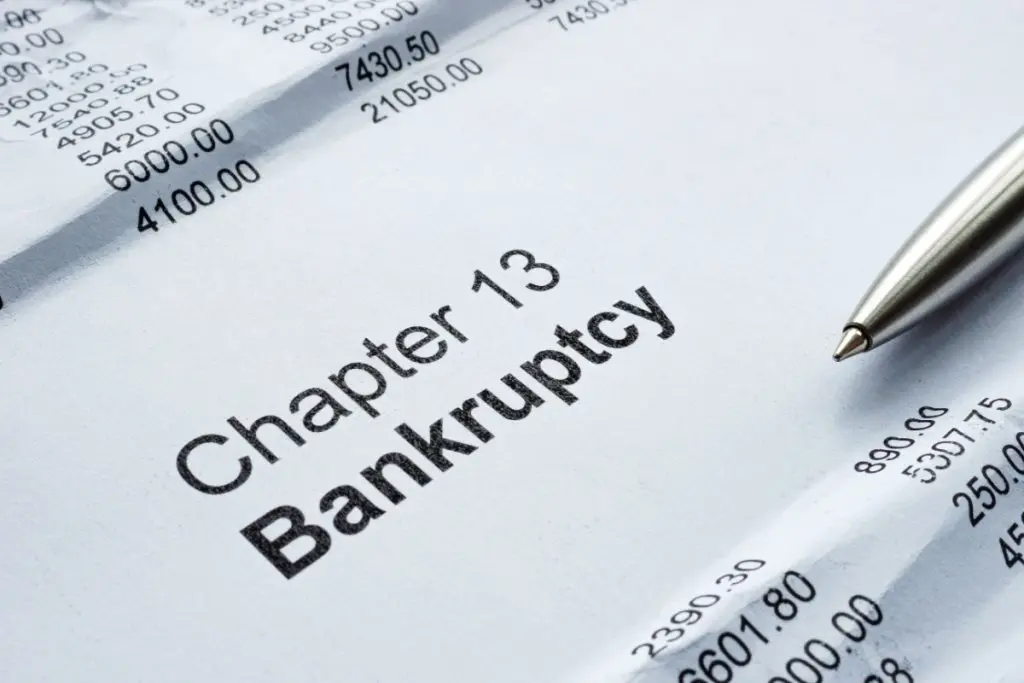Financial challenges can happen to anyone. You’re not alone if you’re in a situation where you’re considering bankruptcy. Understanding the process and when to file for bankruptcy can help you decide if it’s the right option.
Whether filing for bankruptcy is the right option depends on your financial situation. Let’s review some of the necessary considerations, types of bankruptcies available, and consequences to help you make an informed decision.
KEY TAKEAWAYS
- Bankruptcy is a legal process that helps individuals or businesses eliminate or repay their debts under the protection of the federal bankruptcy court.
- There are different types of bankruptcy; the most common ones are Chapter 7 – liquidation bankruptcy and Chapter 13 – reorganization bankruptcy.
- Filing for bankruptcy has serious negative consequences, such as lower credit scores and difficulties renting a home.
Insolvency and Bankruptcy – The Differences
Before you rush and decide when to file for bankruptcy, ask yourself, “Is bankruptcy right for me?” Well, the answer depends on your situation and your financial problems. But first, let’s understand the difference between insolvency and bankruptcy to help you reassess your thoughts. These two terms are related but not the same.
Insolvency can refer to two different financial states: balance sheet insolvency and cash flow insolvency. Balance sheet insolvency is when your liabilities exceed your assets, while cash flow insolvency means you’re unable to pay your debts as they come due. This is a sign that your finances are in trouble, but it doesn’t automatically lead to bankruptcy. You might still be able to get out of this situation by negotiating with creditors, consolidating debts, or getting help from a financial advisor to review your budget.
Bankruptcy is a legal process where you officially declare you cannot pay debts and seek help through the court system. But it’s not as smooth as it sounds. It’s a double-edged sword. On the one hand, it releases certain debts and gives you a fresh start. On the other hand, it imposes severe and long-term consequences that impact your credit score.
Types of Bankruptcy
If you’ve identified the nature of your financial situation, and insolvency is the case, bankruptcy might be an option. Let’s explore what qualifies you for bankruptcies and the most common types.
Chapter 7 Bankruptcy
Chapter 7 is the most common type of bankruptcy. It’s often called “straight bankruptcy” or “liquidation bankruptcy.” This bankruptcy eliminates most unsecured debts and gives you a fresh start. However, in return, you may have to sell some of your assets to pay off creditors. Certain assets may be exempt from liquidation, depending on the state.
Who is it for: Chapter 7 bankruptcy is designed for individuals who cannot realistically pay off their debts. They are often people with low income and few assets. To qualify for filing, you must pass a means test that compares your income and other factors to your state’s average and checks what’s left after allowed expenses.
Types of debts covered: Chapter 7 covers various unsecured debts, such as credit card debt, medical bills, personal loans, utility bills, old lease agreements, judgments from lawsuits, certain business debts, and overdue income taxes if they meet specific criteria.
What happens: After filing, a trustee is appointed to oversee your case and sell your non-exempt assets, like luxury items, second vehicles or homes, and non-essential household goods to pay off creditors. Eligible debts are typically discharged within a few months after the liquidation processes are completed. However, it stays on your credit report for ten years.
Chapter 13 Bankruptcy
Often known as “reorganization bankruptcy,” Chapter 13 allows you to keep your assets while providing you with a court-approved repayment plan. The repayment plan is designed for three to five years, where you pay off all or part of your debts.

Who is it for: Chapter 13 bankruptcy is for individuals who want to protect their assets from liquidation. However, you only qualify if you have a steady income and can commit to a structured payment schedule.
Types of debts covered: Chapter 13 covers a range of debts, including secured debts like mortgages and car loans, unsecured debts like credit card debt, medical bills, and personal loans, as well as priority debts like child support and alimony, recent income taxes, court-ordered fines, and restitution. While student loans and debts from fraud or willful misconduct can’t be discharged, they can still be included in your repayment plan to help manage payments.
What happens: You propose a payment plan of up to five years to the court. If approved, you make regular payments to a trustee, who will distribute the funds to your creditors. Once you have completed the plan, the remaining eligible unsecured debts are discharged. Filing for Chapter 13 stays on your credit report for seven years.
How to File Bankruptcy – the Process
Once you have decided which Chapter is right for you, know that filing for bankruptcy is a complex legal process that requires careful preparation, financial planning, and, most of the time, legal assistance to guide you through the details and protect your rights. Here’s how it works.
Credit Counseling
Before filing, you must complete a credit counseling course from an approved provider. This mandatory course helps you make an informed decision by exploring alternatives to bankruptcy. The 60 to 90-minute course can be completed online, over the phone, or in person.
Filing the Petition
You must gather all your financial documents to file a bankruptcy petition with the court. These include detailed income statements, expenses, assets, and liabilities. This is where you officially declare your intent to file under Chapter 7 or Chapter 13. If you’re filing under Chapter 13, this is also where you submit your repayment proposal to the court for approval.
Pay Filing Fee
Court fees for Chapter 7 are around $338. For Chapter 13, the court fee is $313. You may request a waiver fee or installment plan if you can’t afford court fees.
Automatic Stay
Once you file for bankruptcy, an automatic stay goes into effect. This stops most collection actions, including lawsuits, wage garnishments, and foreclosure proceedings. The automatic stay lasts until your bankruptcy case is closed or dismissed or a creditor gets court approval to lift it.
Trustee Appointment
The court assigns a bankruptcy trustee to oversee your case. In Chapter 7, they will determine which non-exempt assets to sell to pay creditors. In Chapter 13, they make sure you follow your repayment plan and oversee the distribution of payments to creditors.
Meeting of Creditors
After filing, you must attend a “341 hearing”. In this meeting, your trustee will ask you questions about your financial situation and the information you provided in your filing. Creditors may also attend to ask questions, though they usually don’t.
Discharge Period
The discharge period is different for each type of bankruptcy. In Chapter 7, eligible debts are discharged within a few months. In Chapter 13, eligible debts are discharged after you complete the repayment plan, but some may remain.
Consequences of Bankruptcy
Bankruptcy can provide relief from creditors’ actions, but its consequences can affect your financial well-being for years. Is bankruptcy worth it? Let’s talk about its consequences.

- Bankruptcy can lower your credit score significantly and stay on your credit report for up to 10 years.
- With a bankruptcy on your credit report, lenders will view you as a high risk. This means it will take more work for you to get loans. If you do quality, the terms with higher interest rates will be unfavorable.
- If you’re filing under Chapter 7, non-exempt assets might be sold to pay creditors, but most filers can keep essential property thanks to exemptions.
- Since bankruptcy filings are public records, some details about your case can appear if someone runs a background check.
- You may find it difficult to rent a home as most landlords require your credit report as part of their tenant screening process. A bankruptcy on your record can cause them to hesitate.
- Filing for bankruptcy can cause emotional stress since it involves difficult financial decisions and worries about your future and credit.
Filing for bankruptcy is a significant decision for your finances. It can offer a fresh start but damage your credit score for up to 10 years. If you’re still unsure of your situation, consider consulting a bankruptcy attorney to help you with this challenging turn.
Disclaimer: The information in this blog is for informational purposes only and does not constitute legal advice. Please note that bankruptcy laws are subject to change. For up-to-date advice, consult a legal professional.
Bankruptcy FAQs
Do you still have questions? Let’s address them here.
What Qualifies You for Bankruptcy?
Generally, you need to be insolvent. This means that you cannot pay your debts as they come due. However, specific qualifications vary by chapter:
- You must pass a means test if you’re applying under Chapter 7.
- If you’re applying under Chapter 13, you need proof of steady income to show you can repay your debt through a court-approved plan.
Is Bankruptcy Bad?
Bankruptcy is not necessarily “bad” but carries a certain stigma. In the end, it’s a legal process designed to give you relief from your debts. However, it’s not an option you jump into lightly. If you’re considering bankruptcy, carefully weigh its benefits against the long-term consequences.
When to File for Bankruptcy?
Most people file for bankruptcy when their debts become overwhelming, and their income and expenses make it unlikely they’ll pay them off anytime soon. Filing for insolvency is also an option if creditors take aggressive collection actions, such as lawsuits, garnishments, or foreclosure.
Does Bankruptcy Forgive All Debt?
It depends on the type of bankruptcy you’re filing under. Chapter 7 discharges credit card debt, medical bills, personal loans, utility bills, old lease agreements, lawsuit judgments, and specific business debts. Some income tax debts may also be charged if they meet specific criteria, like being at least three years old, filed at least two years prior, and assessed by the IRS at least 240 days before filing.
Chapter 13 can clear certain unsecured debts once you complete the repayment plan. However, you may not be able to discharge some priority debts even after the repayment plan is completed. For example, tax obligations and student loans often survive bankruptcy.